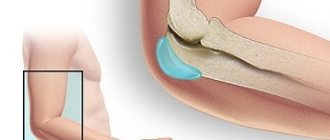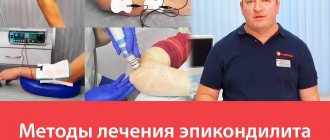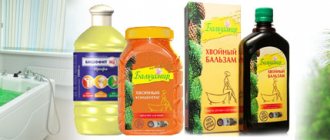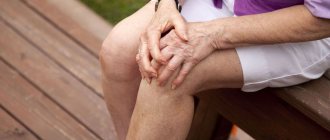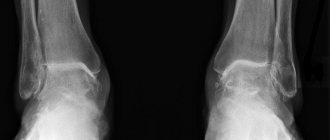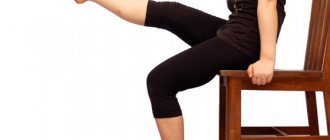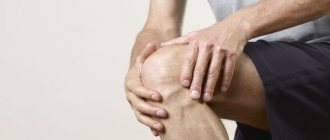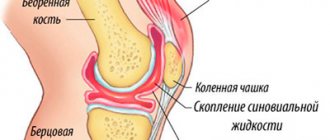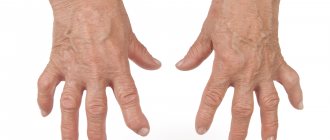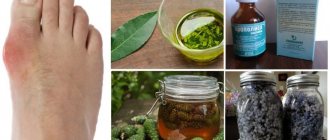Among pathologies of the musculoskeletal system, inflammation of joint tissues occupies a leading place. These diseases are equally common in childhood, adolescence, young and old age. If in children arthritis of the elbow joint most often has a rheumatoid or reactive form, then at a young age this disease can be triggered by the penetration of pathogenic microflora or various types of injuries. In old age, arthritis is a concomitant inflammatory process against the background of the development of degenerative dystrophic joint damage in osteoarthritis.
Arthritis of the right elbow joint is often an occupational disease of seamstresses, cooks, sellers, and painters. With systematic overstrain of the upper limb, which must be kept in a bent state for a long time, deformation of the joint capsule occurs. Toxins and breakdown products can accumulate inside, which are not eliminated in a timely manner during prolonged static muscle tension. Aseptic inflammation of the synovial fluid develops, which quickly spreads to the surrounding cartilage tissue.
Arthritis of the left elbow joint most often has a traumatic etiology. After a bruise, sprain, dislocation or fracture, there is a high probability of droplets of capillary blood penetrating the joint capsule. Against this background, hemarthrosis develops. It can lead to the formation of excess scar tissue. This is fraught with contracture or ankylosis of the bone articulation. To eliminate these negative consequences, it is necessary to carry out comprehensive comprehensive treatment. It must necessarily include etiotropic measures and a rehabilitation complex to restore the mobility and functionality of the upper limb in full.
Bilateral arthritis of the elbow joint most often has a rheumatoid etiology. It can develop against the background of the articular form of ankylosing spondylitis, increased sensitization of the human body, systemic lupus erythematosus, psoriasis, scleroderma, etc.
You can find out more information about the symptoms and treatment of elbow arthritis in this article. And if you need full-fledged effective treatment, we recommend making a free appointment with an orthopedist at our manual therapy clinic in Moscow. Here you will be offered a full inspection. After this, the doctor will make a preliminary diagnosis and give individual recommendations for further examination and treatment.
Causes of Elbow Arthritis
The reasons for the development of elbow arthritis should be considered after a short excursion into the anatomy of this bone joint. It includes three bones: the humerus, radius and ulna. All of them are united by a joint capsule, inside which synovial fluid is located. It nourishes the cartilaginous protective layer of bones and provides shock-absorbing distribution of the load exerted on the upper limb. Three nerves pass through the elbow joint: median, ulnar and radial. They are directed to the hand, where they are responsible for the innervation of tissues. Impaired motor and sensory function of the hand may be due to the fact that a person has suffered arthritis of the elbow joint without appropriate treatment. He developed adhesions and scar deformities. They interfere with the normal passage of nerve fibers. As a complication, hand nephropathy develops.
Potential causes of elbow arthritis include:
- aseptic inflammation during autoimmune processes in the body;
- injury to the elbow joint (sprain and rupture of ligaments and tendons, bruise, crack or fracture of bone tissue, dislocation);
- spread of infection by hematogenous and lymphogenous routes from distant foci of constant presence (tonsillitis, pyelonephritis, dental caries, etc.);
- penetration of infection from an open wound;
- disruption of metabolic processes and exchange in the body (endocrine diseases of the pancreas, thyroid gland, adrenal cortex, etc.);
- gout – increased content of uric acid in the circulating blood and deposition of its crystals in the projection of the joints;
- systemic lupus erythematosus, ankylosing spondylitis in articular form, scleroderma and other rheumatoid processes;
- deforming osteoarthritis;
- tenosynovitis of the elbow;
- instability of the bone position due to sprain of the ligamentous apparatus;
- tumors and dangerous infections (tuberculosis, syphilis, polio).
Predisposing factors are osteochondrosis of the cervical spine, in which the innervation of the tissues of the upper extremities is disrupted, diabetes mellitus, which can provoke angiopathy and insufficiency of blood supply, excess body weight, constant tension of the arm in the elbow when performing professional duties.
Before starting treatment for arthritis of the elbow joint, the doctor must try to identify and eliminate the effect of a potential pathogenic factor. If the cause of the disease is not eliminated, then treatment will give only short-term results. Then symptoms of relapse appear and the disease becomes chronic. And this is fraught with the fact that within a few years a person’s elbow joint will completely collapse and deforming osteoarthritis will occur.
Universal recipes
- The joint can be massaged with honey without additives. Just take honey and rub it into your elbow for fifteen minutes until it is absorbed. After the honey massage, tie a burdock leaf and apply an insulating bandage. Leave until morning. Ten evenings of honey massage relieve swelling and restore mobility.
Baths for the elbow joint
- Sea salt baths are also useful for pain in the elbow joint. Dissolve three tablespoons of salt in a liter of warm water, dip your elbow in the solution and hold for half an hour. If you don’t have sea salt, you can use coarse sea salt for the bath. After the bath, apply a warm bandage.
- Celandine juice will relieve inflammation and pain. Soak cotton pads in the juice of the plant and apply to the joint for half an hour. After removing the lotion, lubricate with unrefined vegetable oil.
- Compresses made from white or red clay reduce swelling and relieve inflammation. Apply clay diluted with water to the consistency of sour cream to the joint for two hours. Wrap in plastic and warm cloth.
- A very old but effective remedy. Pick young birch leaves. Pour boiling water over them for five minutes. Then place the leaves on the joint and secure for half an hour. Carry out this treatment for ten days in a row and the disease will recede.
- Another summer treatment. Pick a few buttercups, the whole plant, but without the root, as it is very poisonous. Pour a glass of boiling water and leave until cool. Pour warm water into a container for a local bath, pour in the buttercup infusion and immerse your elbow in it for twenty minutes.
- You can make night compresses with buttercup infusion.
Signs and symptoms of elbow arthritis
The first signs of arthritis of the elbow joint are acute pain, which is accompanied by swelling and hyperemia of the skin around the joint of the bones. Soft tissue swelling gradually increases. Mobility in the affected joint becomes difficult. With a bilateral inflammatory process, both hands suffer equally.
Clinical symptoms of elbow arthritis depend on the form of the pathology. If this is a purulent septic process, then the patient’s general well-being suffers:
- body temperature rises;
- muscle aches, chills, weakness, increased sweating appear;
- severe headaches.
On examination, redness and swelling around the elbow joint are visible. Swelling hinders movement. Palpation is painful. There are no crunches, squeaks or clicks when moving. The X-ray image does not show any degenerative changes in bone tissue. With the development of gouty arthritis, X-rays may reveal tophi - nodules filled with deposits of uric acid salts.
Methods for treating elbow pain
The elbow of the right hand hurts (it must be treated immediately) - in case of a serious injury, the doctor suggests orthopedic devices to immobilize the damaged joint:
- fixing bandage;
- bandage;
- gypsum;
- splint;
- orthosis
The specialist can also recommend medications suitable for each specific case.
Medications
They are the mainstays in treating elbow problems. The most commonly prescribed drugs are non-steroidal anti-inflammatory drugs (NSAIDs). Their action is quite fast, but superficial. Non-steroids fight inflammation and eliminate pain, but not the cause itself. They are designed to eliminate pain in order to alleviate the patient's suffering.
There are currently dozens of NSAIDs available in various forms.
The most common of them:
| Name | Form | Approximate cost |
| Diclofenac | Ointment/Gel, 30 g Solution for injection, 25 mg/ml Tablets, 50 mg | From 16 rub. From 42 rub. (for 5 – 10 ampoules) From 27 rub. (for 20 tablets) |
| Nimesulide | Tablets, 100 mg | From 30 rub. (for 20 tablets) |
| Indomethacin | Ointment 10%, 40 g Tablets, 25 mg Rectal suppositories, 50/100 mg | From 36 rub. From 15 rub. (for 30 tablets) From 52 rub. (for 10 pcs.) |
| Celecoxib | Capsules, 200 mg | From 141 rub. (for 10 capsules) |
| Meloxicam | Solution for injection, 15 mg/ml Tablets 7.5/15 mg | From 291 rub. (for 5 ampoules) From 152 rub. (for 10 tablets) |
| Ketorolac | Solution for injection, 30 mg/ml Tablets 10 mg | From 51 rub. (for 10 ampoules) From 15 rub. (for 10 tablets) |
| Ibuprofen | Ointment 5%, 25 g Tablets, 200 mg | From 28 rub. From 28 rub. (for 50 tablets) |
| Naproxen | Tablets, 250 mg | From 131 rub. (for 10 tablets) |
| Piroxicam | Capsules, 10/20 mg | From 19 rub. (for 20 capsules) |
Ibuprofen will help relieve pain in the elbow of the right hand.
These medications should not be used constantly. They are sold without a prescription, but have many side effects.
Another group of drugs prescribed for elbow pain are chondroprotectors. Their functions are the healing of cartilage tissue, while relieving pain, and leveling the process of dystrophy. The basis of such drugs are 2 components – chondroitin and glucosamine. They are a natural building material of cartilage tissue.
Treatment with these drugs takes a long time - over 3 months. First they are prescribed in injections, and then in tablets. To maintain maximum effect, the course of treatment is repeated annually.
The most popular chondroprotectors:
| Name | Form | Approximate cost |
| Structum | Capsules, 500 mg | From 1200 rub. (for 60 capsules) |
| Alflutop | Solution for injection, 10 mg/ml | From 1453 rub. (for 10 ampoules) |
| Chondroxide | Cream 8%, 50 g Gel 5%, 40 g Tablets, 250 mg | From 499 rub. From 318 rub. From 500 rub. (for 60 tablets) |
| Teraflex | Cream 30/50/100 g Capsules | From 307 rub. From 979 rub. (for 60 capsules) |
| Noltrex | Syringe 2.5 ml | From 2500 rub. |
| Chondrolone | Solution for injection, 0.1% 1 ml | From 778 rub. (for 10 ampoules) |
For severe pain, injections may be prescribed directly into the joint. Such injections provide quick relief. But doctors do not recommend using this treatment constantly - along with the injection, an infection can be introduced into the joint.
For intra-articular injections use:
- chondroprotectors;
- hyaluronic acid;
- corticosteroid hormones
The last group of drugs has an almost immediate effect on the sore joint, effectively copes with inflammation, but has many contraindications. However, they are extremely popular with patients.
Most often used:
| Name | Form | Approximate cost |
| Diprospan | Suspension for injection | From 110 rub. (for 1 piece) |
| Kenalog | Suspension for injection, 40 mg/ml | From 451 rub. (for 5 pcs.) |
| Flosteron | Suspension for injection | From 3950 rub. (for 5 pcs.) |
| Metipred | Powder for injection, 250 mg | From 199 rub. (for 1 piece) |
| Depo-Medrol | Suspension for injection, 40 mg/ml | From 678 rub. (for 1 piece) |
Injections are prescribed 1 every 2 weeks. A full course includes 3-5 injections. Corticosteroids do not affect the disease itself, so they cannot provide complete treatment.
My right elbow hurts (can also be treated with hyaluronic acid) as a result of injuries or joint diseases. The drug is injected into the joint when there is a lack of fluid in it. As a result, nutrition improves and restoration of cartilage tissue accelerates.
Today, the following medications with hyaluronic acid are used:
| Name | Form | Approximate cost |
| Ostenil | Syringe, 20 mg/2 ml | From 2800 rub. |
| Fermatron | Syringe, 1% solution, 2 ml | From 3190 rub. |
| Sinokrom | Syringe, 1% solution, 2 ml | From 2950 rub. |
Why is purulent arthritis of the elbow joint dangerous?
Purulent arthritis of the elbow joint can develop only when an infectious agent penetrates the joint capsule. The causes of this form of the disease may be:
- wounds with violation of the integrity of the joint capsule (knife, traveling, stabbing);
- surgical intervention, including arthroscopy for diagnostic purposes, carried out in violation of the rules of asepsis and antisepsis;
- intra-articular injection or puncture;
- spread of infection from foci of chronic presence in the human body through the blood and lymphatic fluid.
The purulent form has a severe course. The body temperature rises, the person loses working capacity. Fluctuation is determined in the joint area. The patient feels pulsation and tremors in the area of suppuration. For treatment, a puncture is performed to remove the pus and rinse the joint cavity with antiseptic solutions. Etiotropic antibacterial therapy is prescribed.
Treatment of epicondylitis
Patients are prescribed rest, anti-inflammatory drugs locally and internally, blockades with diprospan or Kenalog bring good results.
Indications for blockades are limited; they cannot be done for diabetes mellitus or some other diseases.
It is advisable to include physiotherapeutic treatment in complex therapy. For recurrent epicondylitis, periarticular injections with the drug Traumeel are recommended.
In recent years, the kinesiotaping technique has been successfully used to treat epicondylitis. With this method, special adhesive elastic tapes are applied to the forearm and elbow joint area. With their help, it is possible to relax muscles, the overstrain of which causes pain in the places of attachment to the bones. Below are examples of kinesio taping for lateral and medial epicondylitis.
Reactive arthritis of the elbow joint
In most cases, reactive arthritis of the elbow joint accompanies acute colds, flu, sore throat, and tonsillitis. During the period of rising body temperature and increasing general intoxication, a secondary reaction of inflammation of the cartilage tissue occurs in the cavity of some large joints of the upper and lower extremities.
All symptoms increase slowly. Slight swelling and hyperemia are detected. Palpation is painful. Mobility in the joint is not limited.
No specific treatment is required for the reactive form. As a rule, all symptoms go away on their own as the underlying disease is treated. But comprehensive rehabilitation is required, since any inflammatory process entails scar deformation of the joint capsule. If, after suffering purulent or reactive arthritis, complex restorative treatment is not carried out using manual therapy methods, then deforming osteoarthritis of the elbow joint may develop in the distant future.
Types of Bursitis
Like inflammatory processes in other joints, bursitis of the elbow joint is classified into several types. The division is based on the intensity of pain, the nature and causes of inflammation. Classification is important for the treatment of bursitis - the principles of therapy differ for inflammation with different causes and forms of progression.
Depending on the nature of the course, bursitis occurs:
- Acute - develops over several days and is characterized by intense pain. The acute process lasts about a month.
- Chronic – less pronounced inflammation that lasts a long time (up to a year).
- Recurrent - bursitis with periodic periods of exacerbation due to untreated traumatic injury or infection.
Depending on the cause, bursitis can be:
- Specific – among the causes of injury and microtrauma of the joint due to impacts, heavy load or monotonous movements (same type of work).
- Nonspecific - appears as a result of an infectious lesion of the joint. It is caused by diseases such as tuberculosis, untreated soft tissue infections and other pathologies.
Depending on changes in the composition of the intra-articular fluid, bursitis can be:
- Serous - the liquid becomes serum-like. In this case, the inflammatory process occurs relatively easily, without severe pain and swelling of the joint, and it is relatively easy to cure.
- Hemorrhagic - blood is present in the synovial fluid.
- Purulent - acute inflammation due to pathogens. It is usually accompanied by acute pain due to a significant increase in the volume of the joint, and antibiotics are required for treatment.
Post-traumatic arthritis of the elbow joint with contracture
Post-traumatic arthritis of the elbow joint occurs when the integrity of the joint capsule is disrupted. Most often it takes the form of hemarthrosis (accumulation of capillary blood in the joint cavity). When broken down, the formed elements of the blood provoke a pronounced inflammatory reaction. Inflammatory factors are drawn into the lesion, which produce large amounts of fibrin. This substance promotes the formation of scar tissue.
Thus, chronic arthritis of the elbow joint develops with contracture, which without treatment will ultimately lead to complete ankylosis of the upper limb. The arm will stop bending and straightening at the elbow. Joint degeneration will begin with the breakdown of cartilage and bone tissue. Such negative consequences should not be allowed to happen. Seek medical help promptly. If you have had an elbow injury, then undergo full treatment from a traumatologist and then be sure to seek help from rehabilitation specialists.
Injuries
Injuries are quite dangerous violations of the integrity of the elbow. They can be considered bruises, fractures and dislocations, and quite often they are accompanied by damage to blood vessels and nerves. After injury, before the regeneration period begins, the patient experiences severe pain, hematomas, ruptured tendons and deformities. As a result of the bruise, arthrosis or other problems may develop. The main injury to the elbow is a dislocation. It is necessarily accompanied by a bone fracture. A dislocation is accompanied by severe elbow pain, stiffness, and a person loses sensation in the wrist. Damage of this kind requires immediate consultation with a doctor and an x-ray of the elbow joint, which will show the extent of the damage, whether the muscles and nerve endings are affected. The doctor will restore the correct position by reduction, if possible, and apply a plaster splint. If the nerve has been damaged or the coronoid process is fractured, then treatment can only be surgical. Tissue bruising can occur due to a push, compression or blow to the elbow area. Symptoms of a bruise are pain when moving, bruises, increased skin temperature at the site of impact, and swelling. A bruise also requires consultation with a doctor.
Treatment of elbow arthritis
Before treating elbow arthritis, it is necessary to conduct a differential diagnosis and identify the potential cause of its development. If it is a bacterial infection, then antibiotics are prescribed. If blood penetrates into the joint cavity, treatment begins with a puncture in order to remove it from there. In case of traumatic damage to surrounding tissues, primary treatment measures should be aimed at restoring their integrity.
After the acute period has passed and the inflammation has passed, you should not think that everything is over. At this point, it is necessary to begin comprehensive rehabilitation; as practice shows, more than 80% of patients who have suffered acute arthritis of the elbow joint return to the orthopedist after 2-3 years with grade 2-3 deforming osteoarthritis. This is due to the fact that during inflammation the microcirculation of blood and lymphatic fluid is disrupted, and the composition of the synovial fluid changes. It is impossible to restore all these parameters without the help of a doctor. Therefore, the elbow joint continues to slowly deteriorate.
At our manual therapy clinic, elbow arthritis is treated using the following methods:
- osteopathy and massage help restore tissue elasticity, relieve ankylosis, increase microcirculation of blood and lymphatic fluid;
- therapeutic exercises and kinesiotherapy will restore limb mobility to its full physiological extent, strengthen muscles, restore diffuse metabolism, etc.;
- reflexology (acupuncture) allows you to start the processes of regeneration of damaged tissues by using the hidden reserves of the human body;
- physiotherapy speeds up the healing process;
- Laser treatment is used for ankylosis and contracture formation.
You can schedule a free consultation with a doctor at our manual therapy clinic. The doctor will conduct an examination and give individual recommendations for treatment.
Diagnosis of elbow pain
You can find out the reason why problems arise in the elbow of your right or left hand with your local therapist. Having the patient’s medical record in hand, he can quickly diagnose the problem and prescribe treatment. Sometimes, in more complex cases, a conclusion from a more specialized specialist - a neurologist, cardiologist or surgeon - is necessary.
Again, a local doctor can write a referral to them. But if the problem is not obvious, additional research will be needed. Some of them can be carried out at a local medical facility, while others can only be carried out in hospitals or medical centers for an additional fee.
| Type of study | Where to spend | Approximate cost |
| X-ray of the elbow joint | Hospital, medical center (MC) | 350 – 9100 rub. |
| Blood analysis | Clinic, hospital, MC | 0 – 980 rub. |
| Magnetic resonance imaging (MRI) of the elbow joint | Hospital, MC | 2000 – 20300 rub. |
| Arthrography of the elbow joint | Hospital, MC | 1500 – 9100 rub. |
| Puncture (fluid collection) from the elbow | Hospital, MC | 990 – 3000 rub. |
